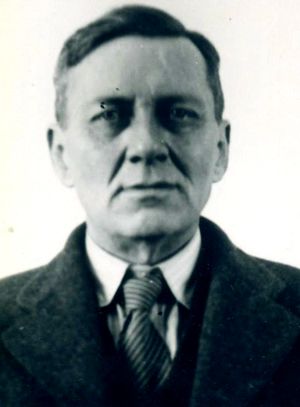Barton Roy Franklin
1883 — 19 April 1947, Berkeley, USA
Biography, education, career:
Roy Franklin Barton is an American ethnographer and researcher of the Philippine peoples, who worked in Leningrad in 1930-s. He was the son of a doctor. After graduating from Illinois Pedagogical Institute (1905), he went to the Philippines as civil service supervising teacher. In 1906-1916, along with his direct duties, Roy Barton conducted ethnographic field research, collecting materials on the peoples of the Philippines, the Ifugao in particular. He amassed an ethnographic collection, which now belongs to the Phoebe A. Hearst Museum of Anthropology in Berkeley. In 1916 he returned to the USA, entered UC Berkeley, majoring in dentistry. It was while a dental student that he began to publish his works on the Ifugao. On graduating from the university, he began to work as a dentist in California. He asked the Carnegie Institution to send him for a year to the Philippines at half what he was earning by dentistry. In 1930, after the publication of his first monograph on the recommendation of Franz Boas, at the beginning of the Great Depression being interested in socialism and weary of personal disarray he moved to the USSR. In 1931 he was employed by Peter the Great Museum of Anthropology and Ethnography of the USSR Academy of Sciences. In November 1935 Roy Barton received a degree of the Candidate of Science without actually defending a thesis. At the MAE (from 1933 – Institute of Anthropology, Archaeology and Ethnography; from 1937 – Institute of Ethnography) Barton was involved in brushing up and systematizing the museum collections from Indonesia and the Philippines, and he published a series of articles on the ethnography of the Philippine peoples. In 1937 he mounted an expedition to the Philippines, funded by the USSR Academy of Sciences, where he amassed a huge collection on the Ifugao. In 1940, after the beginning of WW II, he left the USSR and went straight to the Philippines, where he continued his field research at the expense of the Guggenheim Fund. After the Philippines were occupied by the Japanese troops, he was captured by the Japanese and interned for over three years, first at Baguio camp, then at Las Baiios. After release from camp, he returned to the USA and began to lecture at UC Berkeley, then he received an invitation from the University of Chicago. With his health ruined, he soon died. The archival materials on Roy Barton (1931-1940) are kept in Saint-Petersburg branch of RAS Archive (fund № 142).
Areas of expertise: Traditional culture; Ethnic religious studies; Mythology; Folklore studies; social relations/institutions of pre-state societies, ethnography of the mountain peoples of the Philippines; ethnography of the Ifuago
Major scientific achievements: R.F. Barton is the author of classical research on the ethnography of the Ifugao.
Major publications:
• The Harvest Feast of the Kiangan Ifugao // Philippine Journal of Science, 1911, 6-D-2. P. 81–105;
• An Ifugao Burial Ceremony (with H. Otley Beyer) // Philippine Journal of Science, 1911, 6-D-5. P. 227–252;
• Ifugao Law. University of California Publications in American Archaeology and Ethnology, 1919, 15:1. P. 1–186;
• Ifugao Economics // University of California Publications in American Archaeology and Ethnology, 1922, 15:5. P. 385–446;
• Lawsuit and Good Custom it la Ifugao // Asia, 29, 1929. P. 598–607, 660–664;
• My Ifugao Brother’s Gods // Asia, 29. 1929. P. 806–814, 822–824;
• Hunting Soul-Stuff // Asia, 30. 1930. P. 188-195, 225–226;
• White Man’s Law among Filipino Tribesmen // Asia, 30. 1930. P. 410–416,445–448;
• The Half-Way Sun. 316 pp., 65 pls. Brewer & Warren, Inc., New York, 1930;
• Paths of Vengeance in Luzon // Travel, 55, 1930. P. 24–29, 53;
• Philippine Pagans: The Autobiographies of Three Ifugaos. xxiv, 271 pp., 24 pls. George Routledge & Sons, London, 1938;
• Ифугао, малайское племя нагорной части Филиппин // Советская этнография. 1931. № 1-2. С.116 – 149 [Ifugao – a Malayan tribe of the upland Philippines // Soviet Ethnography. 1931. № 1-2. P.p. 116-149];
• Использование мифов как магии у горных племен Филиппин // Советская этнография. 1935. № 3. С.77 – 95 [Myths as magical artefacts in the mountain tribes of the Philippines // Soviet Ethnography. 1935. № 3. P.p. 77-95];
• За рубежом // Советская этнография. 1935. № 3. С.121 – 122 [Abroad // Soviet Ethnography. 1935. № 3. P.p. 121-122];
• Некоторые новейшие исследования по американскому фольклору // Советская этнография. Сборник статей. № 1. 1938. С.224 – 229 [Latest Research on American Folklore // Soviet Ethnography. A Collection of articles. № 1. 1938. P.p. 224-229];
• Предварительный анализ древнейшего слоя терминов родства у племени ифугао // Советская этнография. Сборник статей. № 3. 1940. С.201 – 206 [A Preliminary Analysis of an oldest layer of Ifugao kinship terms // Soviet Ethnography. A Collection of articles. № 3. 1938. P.p. 201-206];
• Myths and Their Magic Use in Ifugao. Philippine Magazine, 37. 1940;
• Numputol—The Self-Beheaded. Philippine Magazine, 37, 1940. P. 384–386, 394–396;
• Ifugao Somatology (with J. J. Roginsky). Philippine Journal of Science, 74, 1941. P. 349-365;
• Primitive Kalinga Peace-Treaty System. Philippine Magazine, 38, 1941. P. 190–191, 235–237;
• The Religion of the Ifugaos. 219 pp. Memoir 65, American Anthropological Association, 1946.
About Roy Barton:
• A. L. Kroeber. Roy Franklin Barton, 1883–1947 // American Anthropologist Volume 51, Issue 1 (1949);
• Станюкович М.В. Необычная биография (Рой Фрэнклин Бартон) (1883 – 1947) // Советская этнография. 1979. № 1. С.76 – 83 (имеется подробная библиография) [M.V. Stanyukovich. An Unusual Biography (Roy Franklin Barton, 1883-1947) // Soviet Ethnography. 1979. № 1. P.p. 76-83];
• Stanyukovich M. V. R. F. Barton // Russian-American links: 300 years of cooperation. Sankt-Peterburg, 2003.


